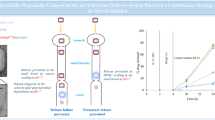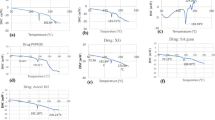Abstract
Purpose. (a) To reduce the swelling properties of guar gum (GG) by crosslinking it with glutaraldehyde (GA), while maintaining its degradation properties in the presence of typical colonic enzymes, (b) to characterize the modified GG and to examine its degradation properties in vitro and in vivo, and (c) to assess, by drug probes with different water solubilities, the potential of the crosslinked GG to serve as a colon-specific drug carrier.
Methods. GG was crosslinked with increasing amounts of GA under acidic conditions to obtain different products with increasing crosslinking densities. These products were characterized by measuring (a) their swelling properties in simulated gastric and intestinal fluids, (b) their crosslinking densities, (c) the release kinetics of three different drugs: sodium salicylate (SS), indomethacin (Indo) and budesonide (Bud) from the crosslinked products into buffer solutions, with or without a mixture of galactomannanase and α-galactosidase, and (d) their in vivo degradation in the cecum of conscious rats with and without antibiotic treatment.
Results. Significant reduction in GG swelling properties, in both simulated gastric and intestinal fluids, was accomplished by its crosslinking with GA. The crosslinking density of the modified GG products was GA concentration-dependent. The release of SS from crosslinked GG discs was completed within 120 minutes. During the same period of time and for more than 10 hours the release of Indo and Bud was negligible. The release rate of the latter two drugs was enhanced when galactomannanase and α-galactosidase were added to the dissolution media. Discs made of the crosslinked GG were implanted in the cecum of rats and their degradation was assessed after 4 days. The extent of degradation was dependent on the amount of GA used for the crosslinking. After 4 days the same discs were recovered intact from rats exposed to antibiotic treatment and from simulated gastric and intestinal fluids.
Conclusions. Reducing the enormous swelling of GG by crosslinking it with GA resulted in a biodegradable hydrogel which was able to retain poorly water soluble drugs, such as Indo and BUD, but not highly water soluble drugs, such as SS, in artificial gastrointestinal fluids. A variety of hydrogels with increasing crosslinking densities were produced and tested for their potential use as colon-specific drug platforms in vitro and in vivo. Their performance did not depend on creating physical barriers by means of compression.
Similar content being viewed by others
REFERENCES
G. Hawksworth, B. S. Drasar, and M. J. Hill. Intestinal bacteria and the hydrolysis of glycosidic bonds. J. Med. Microbiol. 4:451–459 (1971).
M. Ashford, J. T. Fell, D. Attwood, H. Sharma, and P. J. Woodhead. An in vivo investigation into the suitability of pH dependent polymers for colonic targeting. Int. J. Pharm. 95:193–199 (1993).
J. Conchie and D. C. Macdonald. Glycosidases in the mammalian alimentary canal. Nature 184:1233 (1959).
H. N. Englyst, S. Hay, and G. T. Macfarlane. Polysaccharide breakdown by mixed populations of human fecal bacteria. FEMS Microbiol. Ecol. 95:163–171 (1987).
A. Rubinstein. Approaches and opportunities in colon-specific drug delivery. Crit. Rev. Ther. Drug Carr. Sys. 12:101–149 (1995).
A. Rubinstein and I. Gliko-Kabir. Synthesis and swelling dependent enzymatic degradation of borax modified guar gum for colonic delivery purposes. s.t.p. Pharm. Sci. 5:41–46 (1995).
H. Neukom. Galactomannans: properties and applications. Lebensm.-Wiss. u.-Technol. 22:41–45 (1993).
A. A. Lawrence. Natural Gums For Edible Purposes, Noyes Data Corporation, N.J., 1976, pp. 17–55.
S. K. Baveja, K. V. R. Ranga Rao, J. Arora, N. K. Mathur, and V. K. Vinayak. Chemical investigation of some galactomannan gums as matrix tablets for sustained drug delivery. Ind. J. Chem. 30:133–137 (1991).
A. W. Sarlikiotis and K. H. Bauer. Synthese und untersuchung von polyurethanen mit galactomannan-segmenten als hilfsstoffe zur freisetzung von peptid-arzneistoffen im dickdarm. Pharm. Ind. 54:873–880 (1992).
K. O. R. Lehmann and K. D. Dreher. Methacrylate-galactomannan coating for colon-specific drug delivery. Proceed. Int. Symp. Contr. Rel. Bioact. Mater. 18:331–332 (1991).
J. Tomlin, N. W. Read, C. A. Edwards, and B. I. Duerden. The degradation of guar gum by a faecal incubation system. Br. J. Nutr. 55:481–486 (1986).
G. T. Macfarlane, S. Hay, S. Macfarlane, and G. R. Gibson. Effect of different carbohydrates on growth, polysaccharidase and glycosidaseproduction by Bacteroides ovatus, in batch and continuous culture. J. App. Bacteriol. 68:179–187 (1990).
C. T. Reinhart and N. A. Peppas. Solute diffusion in swollen membranes. Part II. Influence of crosslinking on diffusive properties. J. Membrane Sci. 18:227–239 (1984).
B. C. Thanoo, M. C. Sunny, and A. Jayakrishnan. Controlled release of oral drugs from cross-linked polyvinyl alcohol microspheres. J. Pharm. Pharmacol. 45:16–20 (1993).
C.-J. Kim and P. I. Lee. Composite poly(vinyl alcohol) beads for controlled drug delivery. Pharm. Res. 9:10–16 (1992).
M. Grimm, M. Grabenwoger, E. Eybl, A. Moritz, P. Bock, M. M. Muller, and E. Wolner. Improved biocompetability of biprosthetic heart valves by L-glutamic treatment. J. Card. Surg. 7:58–64 (1992).
J. Kawahara, T. Ohmori, T. Ohkubo, S. Hattori, and M. Kawamura. The structure of glutaraldehyde in aqueous solution determined by ultraviolet absorption and light scattering. Anal. Biochem. 201:94–98 (1992).
A. Ya. Sorokin, V. A. Kuznetsova, F. O. Pozdnyakova, L. E. Mal'tseva, M. M. Onopleva, N. A. Domnicheva, and N. O. Shemyakina. Effect of the quality of glutaraldehyde on the properties of crosslinked polyvinyl alcohol. Zhurnal Prikladnoi Khimii, 62:665–669 (1989).
U.S.P. XXIII, United States Pharmacopeial Convention (1995) Rockville, MD, pp. 2053.
N. A. Peppas and E. W. Merrill. Development of semicrystallinepoly (vinyl alcohol) hydrogels for biomedical applications. J. Biomed. Mater. Res. 11:423–434 (1977).
W. R. Sharman, E. L. Richards, and G. N. Malcolm. Hydrodynamic properties of aqueous solutions of galactomannans. Biopolymers 17:2817–2833 (1978).
P. Munk. Introduction to Macromolecular Science, New York, John Wiley & Sons, Chapter 4, 67–98 (1989).
J. E. Mark. Experimental determinations of crosslink densities. Rubber Chem. Tech. 55:762–768 (1982).
J. Kopecek, P. Kopeckova, H. Brondsted, R. Rathi, R. Rihova, P.-Y. Yeh, and K. Ikesue. Polymers for colon-specific drug delivery. J. Contr. Rel. 19:121–130 (1992).
R. W. Korsmeyer and N. A. Peppas. Effect of the morphology of hydrophilic polymeric matrices on the diffusion and release of water soluble drugs. J. Memb. Sci. 9:211–227 (1981).
J. C. Bray and E. W. Merrill. Poly(vinyl alcohol) hydrogels. Formation by electron beam irradiation of aqueous solutions and subsequent crystallization. J. Appl. Polymer Sci. 17:3779–3794 (1973).
P. J. Flory. Principles of Polymer Chemistry, Cornell University Press, Ithaca, N.Y., Chapters 11 and 13, 347–398, 541–593 (1953).
B. V. McCleary, E. Nurthen, F. R. Taravel, and J.-P. Joseleau. Characterization of the oligosaccharides produced on hydrolysis of galactomannan with β-D-mannanase. Carbohydr. Res. 118:91–109 (1983).
D. Wong, S. Larabee, K. Clifford, J. Tremblay, and D. R. Friend. USP dissolution appartus III (reciprocating cylinder) for screening of guar-based colonic delivery formulations. J. Contr. Rel. 47:173–179 (1997).
Author information
Authors and Affiliations
Rights and permissions
About this article
Cite this article
Gliko-Kabir, I., Yagen, B., Penhasi, A. et al. Low Swelling, Crosslinked Guar and Its Potential Use as Colon-Specific Drug Carrier. Pharm Res 15, 1019–1025 (1998). https://doi.org/10.1023/A:1011921925745
Issue Date:
DOI: https://doi.org/10.1023/A:1011921925745




